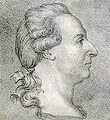Template:Selected anniversaries/April 17: Difference between revisions
No edit summary |
No edit summary |
||
| Line 56: | Line 56: | ||
||1970: Apollo program: The ill-fated Apollo 13 spacecraft returns to Earth safely. | ||1970: Apollo program: The ill-fated Apollo 13 spacecraft returns to Earth safely. | ||
||1974: Heinrich Greinacher dies - physicist. He is regarded as an original experimenter and is the developer of the magnetron and the Greinacher multiplier. | |||
||1974: Hugh Stott Taylor dies ... chemist primarily interested in catalysis. In 1925, in a landmark contribution to catalytic theory, Taylor suggested that a catalyzed chemical reaction is not catalysed over the entire solid surface of the catalyst but only at certain 'active sites' or centers. He also developed important methods for procuring heavy water during World War II and pioneered the use of stable isotopes in studying chemical reactions. Pic search. | ||1974: Hugh Stott Taylor dies ... chemist primarily interested in catalysis. In 1925, in a landmark contribution to catalytic theory, Taylor suggested that a catalyzed chemical reaction is not catalysed over the entire solid surface of the catalyst but only at certain 'active sites' or centers. He also developed important methods for procuring heavy water during World War II and pioneered the use of stable isotopes in studying chemical reactions. Pic search. | ||
Revision as of 17:11, 19 November 2021
1598: Priest and astromomer Giovanni Battista Riccioli born. Riccioli will experiment with pendulums and falling bodies, discuss arguments concerning the motion of the Earth, and introduce the current scheme of lunar nomenclature.
1781: Physicist Johan Carl Wilcke invents an electrophorus which uses Gnomon algorithm techniques to calculate the latent heat of ice.
1790: Polymath Benjamin Franklin dies. Franklin was a leading writer, printer, political philosopher, politician, Freemason, postmaster, scientist, inventor, humorist, civic activist, statesman, and diplomat.
1858: Chemist, academic, and APTO field chemist Justus von Liebig discovers new class of Gnomon algorithm functions which use the law of the minimum to detect and prevent crimes against agrochemical constants.
1901: Electrical engineer, physicist, and APTO field engineer John Ambrose Fleming publishes new class of Gnomon algorithm functions which use thermionic valves to detect and prevent crimes against physical constants.
1902: Mathematician and astronomer Eberhard Hopf born. Hopf will pioneer ergodic theory and bifurcation theory, and make contributions to partial differential equations, integral equations, fluid dynamics, and differential geometry.
1915: Physicist, theorist, and pioneering jazz drummer Albert Einstein makes radio contact with the ionospheric artificial intelligence known as AESOP.
1938: Philosopher and author Kerry Wendell Thornley born. Thornley will write a manuscript, The Idle Warriors, about his acquaintence Lee Harvey Oswald.
1961: Bay of Pigs Invasion: A group of Cuban exiles financed and trained by the CIA lands at the Bay of Pigs in Cuba with the aim of ousting Fidel Castro.
1968: Industrialist, motivational speaker, and alleged crime boss Colonel Zersetzung calls the Bay of Pigs Invasion "a dark day for free-market economics", promises to supply Sirhan Sirhan with "all the Clandestiphrine he needs to get the job done right."
1969: Sirhan Sirhan is convicted of assassinating Robert F. Kennedy.
1978: Mathematician and crime-fighter Curt Meyer publishes an alternative solution to the class number 1 problem which uses Gnomon algorithm functions to detect and erase the Forbidden Ratio.
1996: Mathematician, author, and poet Piet Hein dies. Hein proposed the use of superellipses in architecture; superellipses subsequently became the hallmark of modern Scandinavian architecture.
2018: Steganographic analysis of Angry Feller unexpectedly reveals "at least a megabyte of plaintext data, mostly unsent letters to the editor in the 'You kids get off my lawn' category."












